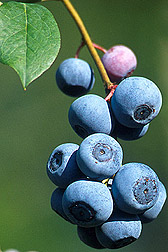Editors Note: While some areas of Arizona grow blueberries better than others, you can find great blueberry recipes on our website at FillYourPlate.org. This article originally appeared on the USDA website.
 By Marcia Wood
By Marcia Wood
September 29, 2010
Blueberries may help fight atherosclerosis, also known as hardening of the arteries, according to results of a preliminary U.S. Department of Agriculture (USDA)-funded study with laboratory mice. The research provides the first direct evidence that blueberries can help prevent harmful plaques or lesions, symptomatic of atherosclerosis, from increasing in size in arteries.
Principal investigator Xianli Wu, based in Little Rock, Ark., with the USDA Agricultural Research Service (ARS) Arkansas Children’s Nutrition Center and with the University of Arkansas for Medical Sciences, led the investigation. The findings are reported in the current issue of the Journal of Nutrition.
Atherosclerosis is the leading cause of two forms of cardiovascular disease—heart attacks and strokes. Cardiovascular disease is the number one killer of Americans.
The study compared the size, or area, of atherosclerotic lesions in 30 young laboratory mice. Half of the animals were fed diets spiked with freeze-dried blueberry powder for 20 weeks; the diet of the other mice did not contain the berry powder.
Lesion size, measured at two sites in the aorta (the artery leading from the heart), was 39 and 58 percent less than that of lesions in mice whose diet did not contain blueberry powder.
Earlier studies, conducted elsewhere, have suggested that eating blueberries may help combat cardiovascular disease. But direct evidence of that effect has never been presented previously, according to Wu.
The blueberry-spiked diet contained 1 percent blueberry powder, the equivalent of about a half-cup of fresh blueberries.
All mice in the investigation were deficient in apolipoprotein-E, a trait which makes them highly susceptible to forming atherosclerotic lesions and thus an excellent model for biomedical and nutrition research.
Wu’s group wants to determine the mechanism or mechanisms by which blueberries helped control lesion size. For example, by boosting the activity of four antioxidant enzymes, blueberries may have reduced the oxidative stress that is a known risk factor for atherosclerosis.
In followup studies, Wu’s group wants to determine whether eating blueberries in infancy, childhood and young adulthood would help protect against onset and progression of atherosclerosis in later years. Early prevention may be especially important in light of the nation’s epidemic of childhood obesity. Overweight and obesity increase atherosclerosis risk.
ARS, the USDA’s principal intramural scientific research agency, operates the Arkansas Children’s Nutrition Center in conjunction with the University of Arkansas for Medical Sciences and the Arkansas Children’s Hospital, all in Little Rock. The blueberry research is one example of ARS investigations that are designed to help improve children’s nutrition and health, a USDA top priority.

